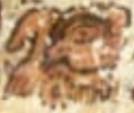


Zender-TRGiCMW.p12.c2.fig10 B3 = HoustonEtAl-TMoB.p246.fig7.21 mayavase.com
Sculpted Throne Back, Museo Amparo Sáenz Throne K5453
ye.<be:ta> ye.<be:ta>
· Zender-TRGiCMW.p13.c2:
o Transliteration: EHM-ye 6-CHAN-na-NAL TE’? ye-be-ta GOD D.
o Transcription: ehm-ey-Ø Wakchanal Paax God; y-ebeet God D.
o Translation: “The Paax God comes down (from) the Six Sky Place; he (is the) messenger of God D”.
· HoustonEtAl-TMoB.p241.pdfp252.c2.l+1: One unprovenanced object, known as the Sáenz Throne after its first owner, shows a pair of royal personages. […] In between them is a deity labeled by specialists as the “Pax god” because his face occurs in inscriptions as the patron of the month Pax. He has no lower jaw, yet he does have, on the throne, a set of wings, and he appears to be conversing with the central male figure in this tableau. The wings alone would signal that he is a messenger of some sort. The text makes this even clearer: the event, although partly obscured, is linked to a supernatural location known as the “six-sky-place,” followed by the head glyph for the little winged god in attendance on the king; the god’s folded arms denote subordinate status. The sign that comes thereafter consists of three syllables, [ye-be-ta], which spells yebeet, “his messenger,” a term descended from Common Mayan *abaaty and cognate with a large set of terms meaning “servant” or “worker” (Kaufman and Norman 1984:119). The name that possesses the winged god and describes him as “his messenger” is none other than Itzamnaaj, who is probably impersonated by the central figure in the throne. The winged supernatural will also, in all likelihood, be the omen, the embodied message of Itzamnaaj. Yet other supernatural messengers, such as God N on an unprovenanced vessel, cannot yet be explained (e.g., K4143).
· Sim: the first (modern) owner of a throne now apparently in the Museo Amparo was named Sáenz:
o His full name was Josué Sáenz Treviño.
o He was also the first modern owner of the CMdM (Códice Maya de México) and the TRT Wooden Box – Gutiérrez&BritoGuadarrama-TARoCMdM.p56.para2: The other possibility [for the provenance of the CMdM] is the site of Tortuguero, Tabasco, located at the mid-point between Villahermosa and Palenque. Sáenz Treviño is said to have acquired other objects at the same time as Códice Maya de México, among them the so-called Tortuguero box (see Turner, "Códice de México," this volume, fig. 2), a carved wooden box bearing the emblem glyph of Tortuguero (Carlson 2012-13, 6).